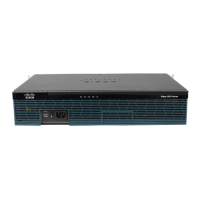324
Cisco 3900 Series, Cisco 2900 Series, and Cisco 1900 Series Integrated Services Routers Generation 2 Software Configuration Guide
Chapter Administering the Wireless Device
Creating a Banner
If you use the wireless device IP address as its hostname, the IP address is used and no DNS query
occurs. If you configure a hostname that contains no periods (.), a period followed by the default domain
name is appended to the hostname before the DNS query is made to map the name to an IP address. The
default domain name is the value set by the ip domain-name command in global configuration mode.
If there is a period (.) in the hostname, Cisco IOS software looks up the IP address without appending
any default domain name to the hostname.
To remove a domain name, use the no ip domain-name name command in global configuration mode.
To remove a name server address, use the no ip name-server server-address command in global
configuration mode. To disable DNS on the wireless device, use the no ip domain-lookup command in
global configuration mode.
Displaying the DNS Configuration
To display the DNS configuration information, use the show running-config command in privileged
EXEC mode.
Note When DNS is configured on the wireless device, the show running-config command sometimes
displays a server IP address instead of its name.
Creating a Banner
You can configure a message-of-the-day (MOTD) and a login banner. The MOTD banner appears on all
connected terminals at login and is useful for sending messages that affect all network users (such as
impending system shutdowns).
The login banner also appears on all connected terminals. It appears after the MOTD banner and appears
before the login prompts appear.
Note For complete syntax and usage information for the commands used in this section, see Cisco IOS
Configuration Fundamentals Command Reference.
Step 4
ip domain-lookup (Optional) Enables DNS-based hostname-to-address translation on the wireless
device. This feature is enabled by default.
If your network devices require connectivity with devices in networks for which
you do not control name assignment, you can dynamically assign device names
that uniquely identify your devices by using the global Internet naming scheme
(DNS).
Step 5
end Returns to privileged EXEC mode.
Step 6
show running-config Verifies your entries.
Step 7
copy running-config
startup-config
(Optional) Saves your entries in the configuration file.
Command Purpose

